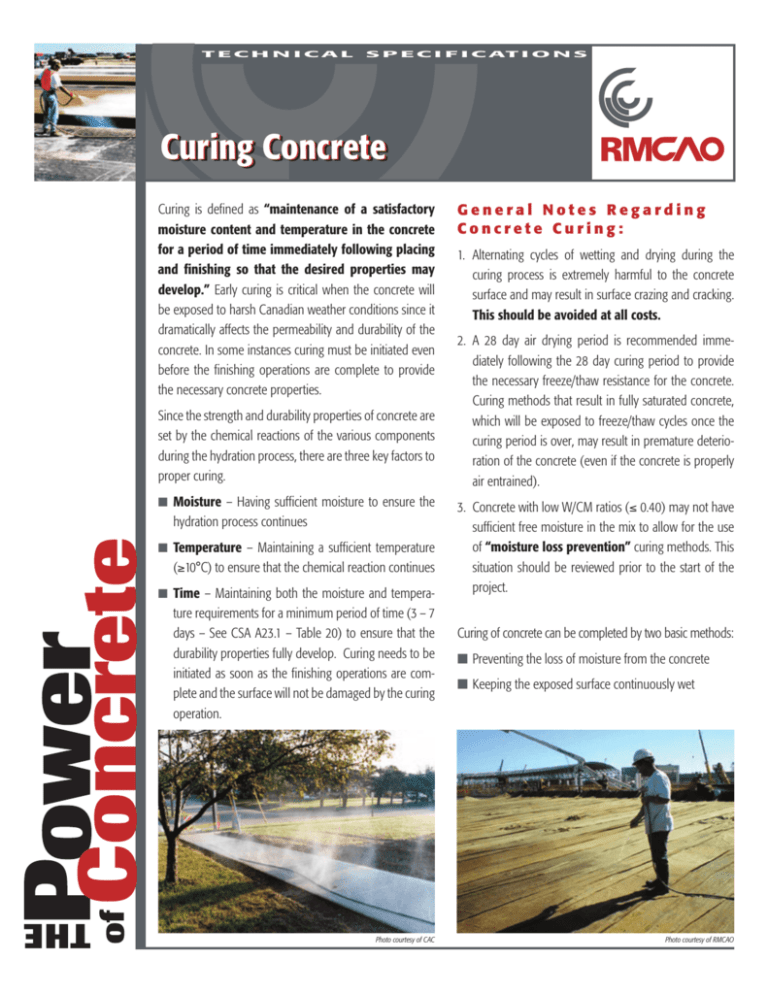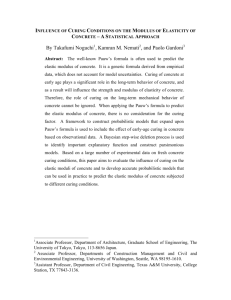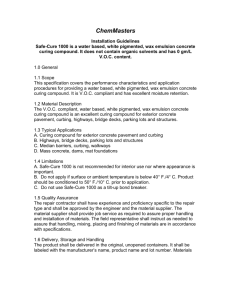
TECH N ICAL
S P E C I F I C AT I O N S
Curing Concrete
Curing is defined as “maintenance of a satisfactory
moisture content and temperature in the concrete
for a period of time immediately following placing
and finishing so that the desired properties may
develop.” Early curing is critical when the concrete will
be exposed to harsh Canadian weather conditions since it
dramatically affects the permeability and durability of the
concrete. In some instances curing must be initiated even
before the finishing operations are complete to provide
the necessary concrete properties.
Since the strength and durability properties of concrete are
set by the chemical reactions of the various components
during the hydration process, there are three key factors to
proper curing.
■ Moisture – Having sufficient moisture to ensure the
hydration process continues
■ Temperature – Maintaining a sufficient temperature
(≥10°C) to ensure that the chemical reaction continues
■ Time – Maintaining both the moisture and tempera-
ture requirements for a minimum period of time (3 – 7
days – See CSA A23.1 – Table 20) to ensure that the
durability properties fully develop. Curing needs to be
initiated as soon as the finishing operations are complete and the surface will not be damaged by the curing
operation.
Photo courtesy of CAC
General Notes Regarding
Concrete Curing:
1. Alternating cycles of wetting and drying during the
curing process is extremely harmful to the concrete
surface and may result in surface crazing and cracking.
This should be avoided at all costs.
2. A 28 day air drying period is recommended immediately following the 28 day curing period to provide
the necessary freeze/thaw resistance for the concrete.
Curing methods that result in fully saturated concrete,
which will be exposed to freeze/thaw cycles once the
curing period is over, may result in premature deterioration of the concrete (even if the concrete is properly
air entrained).
3. Concrete with low W/CM ratios (≤ 0.40) may not have
sufficient free moisture in the mix to allow for the use
of “moisture loss prevention” curing methods. This
situation should be reviewed prior to the start of the
project.
Curing of concrete can be completed by two basic methods:
■ Preventing the loss of moisture from the concrete
■ Keeping the exposed surface continuously wet
Photo courtesy of RMCAO
Possible curing methods are outlined in the following table:
Moisture Loss Prevention
■
■
■
Supplying Supplemental Moisture
Curing Compounds
• Form a membrane over the top surface of the concrete preventing
moisture loss
• Must be applied at the manufacturers suggested application rate
• Should be applied in two applications with the second being at right
angles to the first to ensure uniform coverage
• Should be applied as soon as the concrete surface is finished and
when there is no free water on the surface
• Curing compounds can effect the “bond” of some floor coverings
• Confirm that this curing method is suitable for the final floor covering
application
Plastic Sheeting
• Ensure that the plastic sheeting covers 100% of the concrete
surface and that it is adequately sealed at the edges to prevent
moisture loss
• Select the appropriate colour (white, black, or clear) of the plastic
based upon the ambient air conditions
• If uniform colour is a requirement for the project ensure that the
plastic is not placed directly on the concrete surface
• Ensure that plastic sheeting is not damaged by subsequent
construction activities during the curing period
■
Water Ponding
• Flooding of the concrete surface to provide both moisture and a
uniform curing temperature
• Curing water should not be more than 12°C cooler than the concrete
temperature to avoid the possibility of thermal cracking
• The water must cover the entire concrete surface
■
Water Sprinkling
• Spraying water over the concrete surface. The entire concrete surface
must be wet for this method to be effective
• The concrete surface must have sufficient strength to avoid damaging
the surface
• Excess water will run off the concrete and must be drained away
• This protection method can be adversely affected by high winds
which prevent proper curing on the “upwind” side
■
Wet Burlap
• Pre-soaked burlap is applied to the concrete surface and is covered
with plastic to prevent moisture loss or water is reapplied as
necessary to prevent the material from drying out
• Burlap should be rinsed prior to its first use to avoid possible staining
• Materials utilizing both geotextile fabric and plastic top coatings can
be reused throughout the project
■ Wet Sand
Leaving Formwork In Place
• This system is most effective for vertical elements (walls, columns,
• Wet loose material such as sand can be used to cure concrete slabs
beams, etc). Care must be taken to also protect the top surface of the
and footings
concrete appropriately
• The sand thickness must be sufficient to prevent moisture loss at the
• “Breaking” or “Releasing” the formwork dramatically reduces the
concrete surface or the sand must be wetted throughout the curing
effectiveness of this curing method since air flow is now possible
period
between the concrete and the formwork
• If uniform colour is an issue then a uniform curing time and
temperature must also be maintained and form removal scheduled
accordingly
CSA A23.1 – TABLE 20
Allowable curing regimes
(see Clause 4.1.1.1.1, 7.4.1.1, 7.4.1.7.1, and Table 2)
Curing Type
Name
Description
1
Basic
3 d at ≥ 10°C or for a time necessary to attain 40% of the specified strength.
2
Additional
7 d at ≥ 10°C and for a time necessary to attain 70% of the specified strength.
When using silica fume concrete, additional curing procedures shall be used.
See Annex I, Clause 1.3.13.
3
Extended
A wet-curing period of 7 d. The curing types allowed are ponding, continuous
sprinkling, absorptive mat or fabric kept continuously wet.
References:
1 CSA A23.1-04 – Concrete Materials and Methods of Concrete Construction,
Canadian Standards Association International
2 Ontario Building Code – 1997, Ontario Ministry of Municipal Affairs and Housing
– Housing Development and Buildings Branch
Supported by
3
4
Design and Control of Concrete Mixtures – 7th Canadian Edition,
Cement Association of Canada
Concrete in Practice #11 – Curing In-Place Concrete, National Ready Mixed
Concrete Association
Technical information prepared by
Ready Mixed Concrete Association of Ontario
365 Brunel Road, Unit #3 • Mississauga, Ontario L4Z 1Z5
Tel: 905.507.1122 • Fax: 905.890.8122 • Email: info@rmcao.org
www.rmcao.org
With permission of Canadian
Standards Association, material is
reproduced from CSA Standard,
A23.1-04/A23.2-04, Concrete
Materials and Methods of
Concrete Construction/Methods
of Test and Standard Practices for
Concrete, which is copyrighted by
Canadian Standards Association,
178 Rexdale Blvd., Toronto,
Ontario, M9W 1R3. While the use
of this material has been authorized, CSA shall not be responsible for the manner in which the
information is presented, nor for
any interpretations thereof. For
more information on CSA or to
purchase standards, please visit
our website at www.shopcsa.ca
or call 1-800-463-6727.
This publication is intended
for general information
purposes only. The
Ready Mixed Concrete
Association of Ontario and
the Cement Association
of Canada disclaim any
and all responsibility and
liability for the accuracy
and the application of the
information contained in
this publication to the full
extent permitted by law.
No part of this publication
may be reproduced in
any form, including photocopying or other electronic
means, without permission
in writing from Ready
Mixed Concrete Association
of Ontario.
© 2005 RMCAO.
All rights reserved. 09/05








